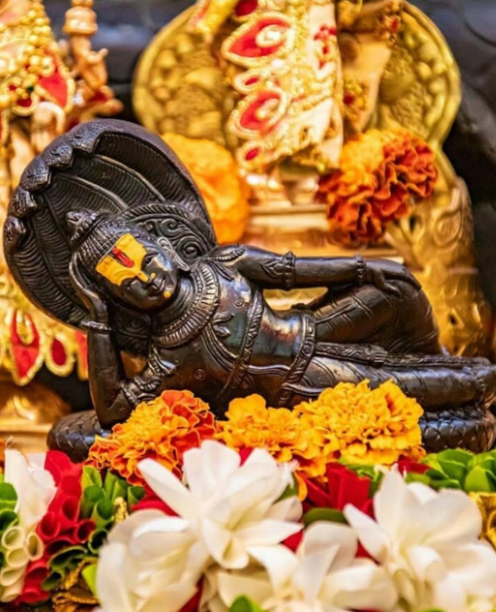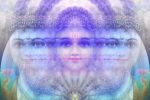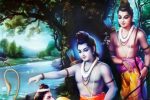NAME 85
Sureśaḥ सुरेशः
Sureśa means the Lord of all gods. Every aspect of creation is represented by a god or goddess. For example, Varuṇa is the god who presides over water; Agni presides over fire, etc. Viṣṇu is the Chief of all such gods and goddesses.
Sureshah – The Lord of the Devas. “ Suranam Isah Suresah ” Eesa means the Lord; Suresa, therefore, indicates the God of gods, the Lord of the Suras. The gods are called as Suras because they are capable of blessing their devotees with a fulfilment of their desires. Therefore, Suresah means One who is the best among those who fulfill all the demands of their devotees (Suras). In short, He is the One who gives the Supreme State of Beatitude and the consequent total liberation from all desires of the ego.
Sri Adi Shankara gives two interpretations for this name.
‘Suraanaam Devaanaam Eeshah Sureshah’ – The Lord of all the Devaas.
‘Shobhanadaatroonaam eeshah Sureshah’ – the chief among those who fulfil the desires of their followers.
And He is su rA Isah – Best among those who can bestow blessings. Sriman Narayana, is the One who can fulfil the ultimate desire of the devotees – that is ‘Moksha’.
८५. ॐ सुरेशाय नमः |
85. OM Sureśāya Namaḥ
Suresah -The denizens of the Heavens are called in the Puranas as Suras. Eesa means the Lord; Suresa, therefore, indicates the God of gods, the Lord of the Suras. The gods are called as Suras because they are capable of blessing their devotees with a fulfilment of their desires. Therefore, Suresah means One who is the best among those who fulfil all the demands of their devotees (Suras). In short, He is the One who gives the Supreme State of Beatitude and the consequent total liberation from all desires of the ego.
Surāṃti dadati iti surāḥ / सुरांति ददति इति सुराः Those who bestow auspicious and good are Surās (gods). He being the Īśa or Lord of such is Sureśaḥ. He is the Lord of the Surās who dower men with good. It can also mean the greatest of those who bestow good.
INTERPRETATION GUIDED BY SANT VANI (WORDS OF SAINTS)
Sureśaḥ
The Lord of all the devas.
He is the Īśa, the Lord of all the suras, devas. Sura need not always mean deva, in the sense of a denizen of the svargaloka. An asura need not necessarily be a demon. Asuṣu ramate iti asuraḥ–
the one who revels in excessive gross sense pursuits or pleasures is an asura. The word Sureśa is a compound word that combines two words sura and īśa – meaning the Master of the Gods i.e Devās. The opposite and sworn enemies are of course the Asurās.
He, who is the master of the Suras i.e. the Devās. He, who is the best among those who can fulfill the wishes of the devotees. (Śaṅkara).He is Sureśa because it is he who confers on all Devās (including Brahma and Rudra) their respective roles. (Parāsara Battar)
Who really are the Devās and the Asurās? In Chapter-9; verses 23 & 25 of the Bhagavad gītā, Bhagavan makes a mention of the Devās:
येऽप्यन्यदेवता भक्ता यजन्ते श्रद्धयान्विता: |
तेऽपि मामेव कौन्तेय यजन्त्यविधिपूर्वकम् || 23||
ye ’pyanya-devatā-bhaktā yajante śhraddhayānvitāḥ
te ’pi mām eva kaunteya yajantyavidhi-pūrvakam
यान्ति देवव्रता देवान्पितॄ न्यान्ति पितृव्रता: |
भूतानि यान्ति भूतेज्या यान्ति मद्याजिनोऽपि माम् ||25||
yānti deva-vratā devān pitṝīn yānti pitṛi-vratāḥ
bhūtāni yānti bhūtejyā yānti mad-yājino ’pi mām
These two verses are interpreted by most commentators as Bhagavan (Kṛṣṇa) meaning to say that even those who worship other Devās and Gods also in reality worship only me (verse-23) and those who worship the “lesser” Gods and beings go to “them” and those who worship me, come to me (verse-25) – Technically, this is correct, but I have a slightly different take on this:
What Bhagavan (Kṛṣṇa) is actually talking about is the fact that we can do all we want in pursuit of material benefits but if you really want to understand who you really are and what your real goal in life is and actually break the birth-death-birth cycle, then you must turn inward and realize the in-dwelling Kṛṣṇa who is THE ONE WHO HAS BECOME THE MANY” and the one reality that pervades and interpenetrates every being and everything in the Universe – and therefore worship him who is the one Sureśa to whom even the Gods (including Brahmā) finally go to. Kṛṣṇa is saying that people depending on their Gunas i.e. tendencies go around but finally they have to come to me – the last and sole refuge of all.
Then there is the shloka that is uttered three times everyday during the Sandhyāvandanam which again confirms this:
आकाशात् पतितं तोयं यथा गच्छति सागरम् ।
सर्वदेवनमस्कारः केशवं प्रति गच्छति ॥
ākāśāt patitaṃ toyaṃ yathā gacchati sāgaram |
sarvadevanamaskāraḥ keśavaṃ prati gacchati ||
As the rain that falls from the sky always winds it way to the Ocean, so also worship of any divinity ultimately reaches that one Supreme being – Keśava.
Also,
शान्ताकारं भुजगशयनं पद्मनाभं सुरेशम्।विश्वाधारं गगनसदृशं मेघवरणं शुभांगम्॥लक्ष्मीकांतं कमलनयनं योगिभिर्ध्यानगम्यम्।वंदेविष्णुं भवभयहरं सर्वलोकैकनाथम्॥
As the first line of the above shloka says:
That serene personality reclining on that ancient serpent, he whose navel holds the lotus of creation – that person is Sureśam…
In Sri Aurobindo’s book “Essays on the Gītā” there is a chapter on ‘Devās and Asurās‘ The following excerpts/passages are from that chapter. The book itself is a must-read for people trying to understand the Bhagavad gītā from a completely different perspective:
——-Quote
The Deva is capable of a high self-transforming sattwic action, the Asura incapable. We must see what is the object of this preface and the precise bearing of this distinction. The general nature of all human beings is the same, it is a mixture of the three gunas; it would seem then that in all there must be the capacity to develop and strengthen the sattwic element and turn it upward towards the heights of the divine transformation.
That our ordinary turn is actually towards making our reason and will the servants of our rajasic or tamasic egoism, the ministers of our restless and ill-balanced kinetic desire or our self-indulgent indolence and static inertia, can only be, one would imagine, a temporary characteristic of our undeveloped spiritual being, a rawness of its imperfect evolution and must disappear when our consciousness rises in the spiritual scale. But we actually see that men, at least men above a certain level, fall very largely into two classes, those who have a dominant force of sattwic nature turned towards knowledge, self-control, beneficence, perfection and those who have a dominant force of rajasic nature turned towards egoistic greatness, satisfaction of desire, the indulgence of their own strong will and personality which they seek to impose on the world, not for the service of man or God, but for their own pride, glory and pleasure.
These are the human representatives of the Devas and Danavas or Asuras, the Gods and the Titans. This distinction is a very ancient one in Indian religious symbolism.
The fundamental idea of the Rig Veda is a struggle between the Gods and their dark opponents, between the Masters of Light, sons of Infinity, and the children of Division and Night, a battle in which man takes part and which is reflected in all his inner life and action. This was also a fundamental principle of the religion of Zoroaster.
The same idea is prominent in later literature. The Ramayana is in its ethical intention the parable of an enormous conflict between the Deva in human form and the incarnate Rakshasa, between the representative of a high culture and Dharma and a huge unbridled force and gigantic civilisation of the exaggerated Ego. The Mahabharata, of which the Gita is a section, takes for its subject a lifelong clash between human Devas and Asuras, the men of power, sons of the Gods, who are governed by the light of a high ethical Dharma and others who are embodied Titans, the men of power who are out for the service of their intellectual, vital and physical ego.
The ancient mind, more open than ours to the truth of things behind the physical veil, saw behind the life of man great cosmic Powers or beings representative of certain turns or grades of the universal Shakti, divine, titanic, gigantic, demoniac, and men who strongly represented in themselves these types of nature were themselves considered as Devas, Asuras, Rakshasas, Pisachas.
The Gita for its own purposes takes up this distinction and develops the difference between these two kinds of beings, “dvau bhutasargau”.
It has spoken previously of the nature which is Asuric and Rakshasic and obstructs God-knowledge, salvation and perfection; it now contrasts it with the Daivic nature which is turned to these things.
Arjuna, says the Teacher, is of the Deva nature. He need not grieve with the thought that by acceptance of battle and slaughter he will be yielding to the impulses of the Asura. The action on which all turns, the battle which Arjuna has to fight with the incarnate Godhead as his charioteer at the bidding of Deva and Asura the Master of the world in the form of the Time-Spirit, is a struggle to establish the kingdom of the Dharma, the empire of Truth, Right and Justice. He himself is born in the Deva kind; he has developed in himself the sattwic being, until he has now come to a point at which he is capable of a high transformation and liberation from the traigunya and therefore even from the sattwic nature.
The distinction between the Deva and the Asura is not comprehensive of all humanity, not rigidly applicable to all its individuals, neither is it sharp and definite in all stages of the moral or spiritual history of the race or in all phases of the individual evolution. The tamasic man who makes so large a part of the whole, falls into neither category as it is here described, though he may have both elements in him in a low degree and for the most part serves tepidly the lower qualities.
The normal man is ordinarily a mixture; but one or the other tendency is more pronounced, tends to make him predominantly rajaso-tamasic or sattwo-rajasic and can be said to be preparing him for either culmination, for the divine clarity or the titanic turbulence.
For here what is in question is a certain culmination in the evolution of the qualitative nature, as will be evident from the descriptions given in the text. On one side there can be a sublimation of the sattwic quality, the culmination or manifestation of the unborn Deva, on the other a sublimation of the rajasic turn of the soul in nature, the entire birth of the Asura. The one leads towards that movement of liberation on which the Gita is about to lay stress; it makes possible a high self-exceeding of the sattwa quality and a transformation into the likeness of the divine being, vimoksāya . The other leads away from that universal potentiality and precipitates towards an exaggeration…
——-Unquote
PLEASE WATCH
No problem with gross material indulgence that except that such a person is bound to go against dharma if he develops Asuric tendencies in such persuits, because the pressure of fulfilling the sense pleasure is so strong. Majority of the people will justify an extramarital affair also with adequate reasons to justify sense pleasures. I hear some people arguing that an extra marital affair is not just physical. Whatever be the nature or level of intimacy, if you would not want to be treated that way, then, it is time to think about one’s svadharma. When pleasure, power and position are the only priorities for a person, then Īśvara is only at the end of his list of pursuits and not a priority.
As opposed to that, a sura or a deva is an effulgent person. He would be a viveki, a discriminative person, who lives a life in keeping with dharma. Thus, He is Sureśa, the Lord of the people who live a life of dharma backed by viveka. Dharma is a valid puruṣārtha, a human goal. Īśvara manifests as dharma. Universal ethics and values manifest in everyone having an innate understanding of ‘I don’t want to be hurt, cheated or manipulated.’ Likewise, the other does not want to be hurt, cheated or manipulated. It is seemingly straightforward, then where does the slip between the cup and lip happen?
The slip happens when dharma becomes a matter of convenience. If we follow dharma only when we are not inconvenienced, that is not the true understanding of dharma. Dharma is not merely not robbing, not cheating, etc. There are different levels of hurt, different sorts of hurting.
PLEASE WATCH
You can hurt a person by a look or you can hurt a person by a word and you can even hurt a person by deliberately entertaining a certain type of thinking. We can hurt people in so many different ways, and we do so all the time. We suitably justify it too by saying that the other person deserves it and needs to change. Following dharma is not ordinary, it is really for my own sanity and well being. Not hurting another person, not yielding to my own binding cravings and aversions and, on the other hand, conforming to what is right and wrong in the purview of one’s svadharma is the bedrock of our human society. For a sura, a life of dharma is his/her living reality consistently.
The word ‘sura’ can be taken as a word derived from the verbal root ‘rā’ in the meaning of giving, with the prefix ‘su.’ So He is surāṇām, the Lord of all those who bestow good on others.
The devas are there to do good to all the living beings. We see their grace, we acknowledge their roles in our lives. The Lord of all the devas is Indra. Īśvara is the Lord of Indra also. All of them function because of the laws of Īśvara.
Quoting Om Swamiji :
“Rāvaṇa a great tapasvin, represents attainment of supreme one pointed concentration. His ten heads are but the ten senses — conative and cognitive organs. It shows when the senses are one-pointed (channelized consciousness) but misdirected, one wrongly uses one’s power. There is no hope for the yogi who has attained such a state of mind but is still a servant of his lust and rage. That yogin who stops just after perfecting the yogic practices rather than the actual samādhi, trance, can still fall for vikāra, the restive tendencies of the mind. And the one who fails to carry out a penetrating analysis into the reality of things in his trance will continue to be a regular victim of such tendencies.
For, the real work begins once you get to samādhi and are able to maintain it. The elixir in the navel hints at the yogic secret and importance of the maṇipur chakra, the psychoneurotic plexus of navel.
Śrī Rāma represents the samādhistha purῡśa (the adept firmly established in his tranquil equipoise). But he goes further, he treads the path of dharma and compassion. Consequently, he is not confused about right from wrong. Mā Sītā, represents the purity and power of prakriti (Nature) and the feminine aspect, kuṇdalinī.
It shows when the yogi is as accomplished as Rama, Nature surrenders to such a man and becomes his devotee. And misdirected senses (Ravana) fails to lure such devotee. Lakshmana shows the need for resolve for the yogi. Lakshmana was a master of sleep and lust and lived an austere life for fourteen years. The path of yoga requires control and discipline. The fourteen years indicate an average timeframe to attain the supreme enlightenment.
So, to succeed on the path of yoga, one needs to have the dharma and maryādā (moral and righteous conduct of speech, action and thoughts) of Rama, the tyāga (detachment and dispassion) of Lakshmana and the purity of Sita. Victory is not far for such seeker.”
PLEASE READ
https://os.me/diwali-the-festival-of-lights-its-esoteric-meaning/



